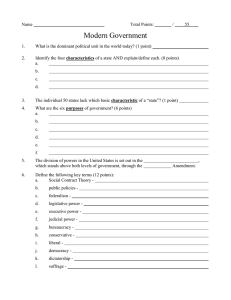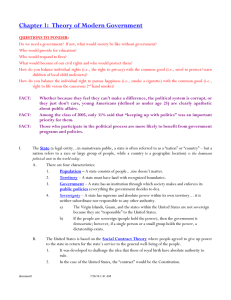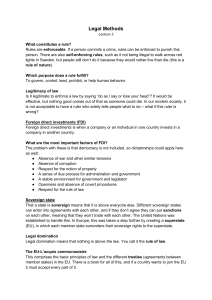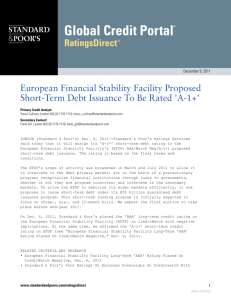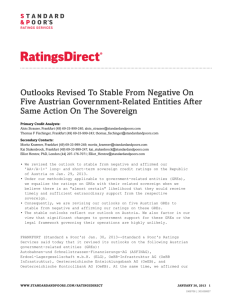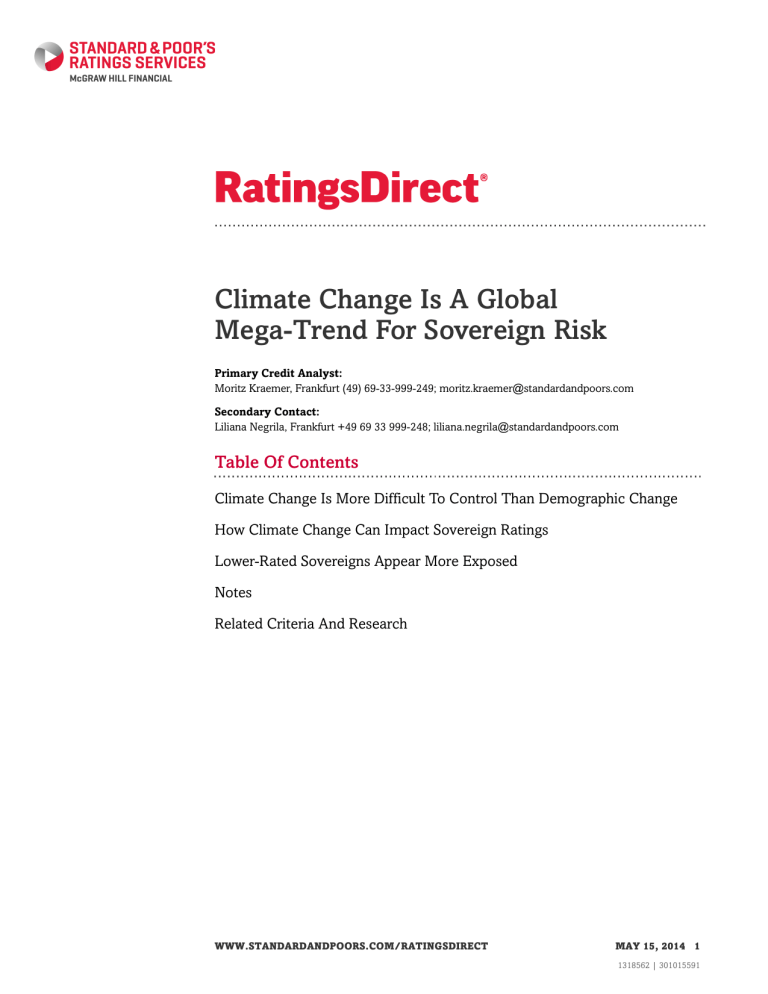
Climate Change Is A Global Mega-Trend For Sovereign Risk Primary Credit Analyst: Moritz Kraemer, Frankfurt (49) 69-33-999-249; moritz.kraemer@standardandpoors.com Secondary Contact: Liliana Negrila, Frankfurt +49 69 33 999-248; liliana.negrila@standardandpoors.com Table Of Contents Climate Change Is More Difficult To Control Than Demographic Change How Climate Change Can Impact Sovereign Ratings Lower-Rated Sovereigns Appear More Exposed Notes Related Criteria And Research WWW.STANDARDANDPOORS.COM/RATINGSDIRECT MAY 15, 2014 1 1318562 | 301015591 Climate Change Is A Global Mega-Trend For Sovereign Risk (Editor's Note: The article published earlier today contained incorrect calculations in our vulnerability index. A corrected version follows.) Since the turn of the century, two mega-trends have emerged to dominate public discussion on global economic risks. The first, global aging, is comparatively well-understood and the consequences relatively clear. The second, the impact of climate change, is far hazier and the potential outcomes much more challenging to predict. For over a decade Standard & Poor's Ratings Services has been regularly assessing the impact that demographic change is likely to have on sovereign creditworthiness. Our conclusion is that over a multi-decade time horizon the financial consequences of aging societies are likely to overshadow all other economic trends for most sovereigns (see "Global Aging 2013: Rising To The Challenge" March 20, 2013). We also expect advanced economies will be more negatively affected than sovereigns in emerging markets. In contrast, while most sovereigns will feel the negative effects of climate change to some degree, we expect the poorest and lowest rated sovereigns will bear the brunt of the impact. This is in part due to their reliance on agricultural production and employment, which can be vulnerable to shifting climate patterns and extreme weather events, but also due to their weaker capacity to absorb the financial cost. Overview • Climate change is likely to be one of the global mega-trends impacting sovereign creditworthiness, in most cases negatively. • The impact on creditworthiness will probably be felt through various channels, including economic growth, external performance, and public finances. • Sovereigns will probably be unevenly affected by climate change, with poorer and lower rated sovereigns typically hit hardest, which could contribute to rising global rating inequality. Another key difference is time frame. The impact of aging societies is already being felt in several advanced economies, most notably Japan, and will steadily increase through the next few decades. For most sovereigns, their demographic profile is such that the full impact of aging on economic performance and public finances will be felt from the mid-2020s or soon after (note: this is well beyond the time-horizon that can be reasonably applied to a sovereign credit rating). Our understanding of climate change, on the other hand, is still developing and we lack sufficient reliable data to make precise predictions on if and when the effects of a warming planet and changing weather patterns will overshadow other factors. This does not imply we should be complacent in developing a clearer view, however. By its very nature of complex and inter-connected ecological systems, weather is inherently unpredictable and the picture can change suddenly and dramatically for an individual country or region. WWW.STANDARDANDPOORS.COM/RATINGSDIRECT MAY 15, 2014 2 1318562 | 301015591 Climate Change Is A Global Mega-Trend For Sovereign Risk Climate Change Is More Difficult To Control Than Demographic Change We believe that alongside aging, climate change, and specifically global warming, is going to be the second global mega-trend affecting sovereign credit risk. We also believe that it will put downward pressure on sovereign ratings during the remainder of this century. However, in our view there are three noteworthy differences that may make climate change an even more challenging problem to grasp than the world's shifting demographic. 1. The science is complex. The economic and financial consequences are much less-well understood than those of aging societies. There remains significant uncertainty about how climate change will impact individual national territories and economies. For example, the fifth assessment report of the Intergovernmental Panel on Climate Change (IPCC) published in 2013 estimates that the average winter temperature in Northern Europe could rise between +2°C to +7°C by 2100. But there is also a chance that the warming in winter will remain within the bounds of a standard deviation of present-day natural variability. Not so in summer, however, where the IPCC estimates that warming is all but unavoidable. The wide array of possible outcomes can confuse politicians and voters alike and can lead to procrastination and inaction. Even in the case of aging, where financial consequences are generally well-studied and documented, we have seen that remedial action has in most countries been slow and difficult. This is usually because the benefits lie in the distant future whereas some of the unpopular consequences are being felt immediately, conspiring against robust action, especially in societies where leaders need to renew their legitimacy regularly through elections. In addition, as many of the beneficiaries do not yet have a political voice, either because they are too young to vote or they have not been born yet. While this argument can be made equally about the difficulty of enacting measures that might curb greenhouse gas emissions, the political impasse is exacerbated by the much higher uncertainty about future climatic conditions. 2. A global, collective action problem. The degree to which individual countries and societies are going to be affected by warming and changing weather patterns depends largely on actions undertaken by other, often far-away societies. Unlike in the case of aging, individual societies cannot by themselves meaningfully reduce the impact they will feel as the climate changes. This is the global collective action problem that has been characterizing climate negotiations ever since the seminal Rio summit in 1992. A society may choose to reduce its carbon emissions unilaterally to reduce the risk of the potential consequences of global warming, but due to the global character most of the benefits of that society's sacrifice will accrue to other nations. In game theory, this is the famous prisoner's dilemma: each society would be worse off if it were to act alone to mitigate climate change: the society would have all the pain for negligible gain. On the other hand it would be better-off if it shirked an international concerted mitigation effort that all other societies undertook: the society would have to take no sacrifice while it benefits from the improvements caused by the actions of others. Typically such an incentive structure leads to uncooperative outcomes and to no effective risk mitigation. This is fundamentally different from tackling the aging challenge: a pension reform, for example, will accrue to the society that enacts it and to that society alone. The spillover benefits for other countries are negligible. WWW.STANDARDANDPOORS.COM/RATINGSDIRECT MAY 15, 2014 3 1318562 | 301015591 Climate Change Is A Global Mega-Trend For Sovereign Risk 3. The impact falls disproportionately on poorer countries. Despite the complex and sometimes controversial science underlying estimates of global warming, we believe that poorer and generally lower rated sovereigns will be disproportionately hit (see below). In contrast, the aging problem is expected to impact highly rated sovereigns more than those with lower ratings. Our aging simulations suggest that in a no-action scenario, the net general government debt ratio of the advanced economies will rise by 150 percentage points between 2010 and 2050 to reach 216% of GDP. Emerging market sovereigns will experience an average increase of just under 120% points to reach a net general government debt ratio of 149%. In other words, the sovereigns that should be best able to address the aging challenge are hit by it more than proportionately. The opposite is likely to be true in the case of climate change. The most affected can be expected to be poorer and to have less clout in international negotiations, exacerbating the international coordination problem described above. How Climate Change Can Impact Sovereign Ratings Extreme weather events, such as tropical storms or floods, seem to have been on the rise since the early 1980s. Data collected by MunichRe, a reinsurer, suggest that weather-related loss-events have risen in all continents, most significantly in Asia and North America, where they increased more than fourfold. In Eastern Asia overall losses (insured and non-insured) used to be below $10 billion per year, but have regularly surpassed $20 billion during the last decade with a peak of over $50 billion (1). Typhoon Haiyan hitting The Philippines in November 2013 has been a powerful and hugely destructive reminder of this trend. Despite the grave loss of life and the devastation caused by extreme weather events, Standard & Poor's has not revised the rating of a sovereign as a consequence. We have taken a view that the size of the devastation, while large in absolute terms, has so far not been sufficient to impact the rating overall. However, assuming that extreme weather events are on the rise in terms of frequency and destruction, how this trend could feed through to our ratings on sovereign states bears consideration. We analyse sovereigns applying our ratings methodology ("Sovereign Government Rating Methodology And Assumptions" June 24, 2013). This incorporates the specific assessment of five key factors: institutional and governance effectiveness, economic structure and growth prospects, external liquidity and international investment position, fiscal performance and flexibility, and monetary flexibility. Unless environmental disasters undermine national institutions and governance to an unprecedented degree (e.g. through massive population migration or political instability), we believe that the main factors through which climate change could feed through to sovereign creditworthiness are economic, fiscal, and external performance. Economic performance. There are multiple channels through which climate change can affect the growth prospects of national economies and eventually levels of prosperity. Some of the most potent may be changing patterns of rainfall that can reduce agricultural yields via repeated and prolonged droughts, heat waves and wildfires, or floods. The productivity of the broader workforce could also be negatively impacted if weather events affect sanitary conditions negatively, spreading pests or diseases, increasing morbidity. This may become a particular burden for populations living in low areas close to sea-level, where rising sea-levels in the context of global warming will not only flood agricultural and densely WWW.STANDARDANDPOORS.COM/RATINGSDIRECT MAY 15, 2014 4 1318562 | 301015591 Climate Change Is A Global Mega-Trend For Sovereign Risk populated urban areas, but where a rising water table could lead to salinization of the population's water supply. Extreme weather events, especially floods, can be expected to increasingly take a toll on a country's infrastructure and thus productivity, exacerbating weakening endowment of productive infrastructure observable in a number of countries (see "Cracks Appear In Advanced Economies' Government Infrastructure Spending As Public Finances Weaken", Jan. 14, 2014). The most direct and tragic economic cost is of course the loss of life, such as the more than 6,000 deaths estimated in the Philippines in the aftermath of typhoon Haiyan. In China, an average 3,000 flood-related deaths are estimated to have occurred each year since 1980. During the 1990s, Flood losses oscillated to 2% of Chinese GDP per year, before dropping to below 1% as a consequence of enhanced flood management (2). How climate change will impact GDP growth is highly uncertain. Some research estimates the annual consumption loss in 2100 as a fraction of global GDP would be around 2%, but jump to well over 5% should the annual global temperature rise twice as fast as in the current scientific baseline scenario (3). The estimates for specific regions or even countries are even more variable, as the IPCC's "Atlas of Global and Regional Climate Projections" illustrates. But the evidence suggests that it is probably safe to expect that for most national economies, other things being equal, climate change will negatively impact national welfare and economic growth potential. Observations corroborating this expectation could lead Standard & Poor's to lower sovereign ratings on the most affected sovereigns. Fiscal performance. The potential negative impact on growth will by itself weigh on public finances as tax revenues are likely to lose buoyancy if the underlying national economy falters. Government budgets could come under additional pressure as disaster recovery and emergency support for affected populations is likely to fall on the state in most cases. The same can be expected for the reconstruction of economic and social infrastructure. This can be a large burden for the public budget and, contrary to the fiscal impact from aging societies, it can hit the budget without much prior notice. An extreme example of a natural disaster (although not weather-related) overwhelming the government's financial capabilities has been the violent volcanic eruption on the small Caribbean island of Montserrat in July 1995, which rendered half of the island uninhabitable. The island, being an overseas territory of the U.K., was able to cope due to extremely significant foreign grants, which continue to contribute roughly half of its GDP for budget support and infrastructure investment (see: Montserrat, Nov. 8, 2013). Larger economies would not be able to count on external support on the same scale, especially if climate-related fiscal pressures were to increase in many countries simultaneously. National budgets would invariably come under additional strains, potentially putting downward pressure on sovereign ratings as debts and deficits mount. External performance. Some nations depend on exports of agricultural products for foreign currency. With erratic weather patterns or increasingly frequent droughts or floods undermining the export base, the adequacy of foreign reserves may become threatened as trade imbalances rise. Of course national currencies could depreciate to an extent to recalibrate imports and exports, but this would in many cases come at the price of rising inflation and falling levels of prosperity. Should episodes of bad harvests increase, emergency food imports may be required, once again putting pressure on the country's external accounts. Should global food production stagnate as climate conditions change, prices for agricultural goods would permanently increase. Terms of trade of net food importers would worsen, putting pressure on their external accounts, which in turn could increase the downside risks for sovereign ratings. WWW.STANDARDANDPOORS.COM/RATINGSDIRECT MAY 15, 2014 5 1318562 | 301015591 Climate Change Is A Global Mega-Trend For Sovereign Risk Lower-Rated Sovereigns Appear More Exposed Great uncertainty still remains about if, how, and when various economies could be affected by climate change. Nevertheless, there are various ways through which we can attempt to gauge the vulnerability of individual sovereigns. While there is no single best measure to measure the degree to which various economies are exposed to the risks, we can use a composite of three different variables to capture different facets of potential vulnerability and arrive at a crude ranking: 1. Share of the population living in coastal areas below five meters of altitude. The livelihood and economic production of that population may be at risk should sea levels rise in the course of global warming (World Bank, World Development Indicators). 2. Share of agriculture in national GDP. This measures the risk to the sector that is typically most dependent on climatic conditions. (World Bank, World Development Indicators, Food And Agriculture Organization Of The United Nations Statistical Yearbook 2012) 3. The vulnerability index compiled by Notre Dame University Global Adaptation Index (ND-GAIN), which measures the degree to which a system is susceptible to, and unable to cope with, adverse effects of climate change. The index includes three components: exposure, sensitivity and adaptive capacity (http://index.gain.org/ranking). For each of the three variables, we rank the 116 rated sovereigns for which all three variables are available. A rank number of 1 indicates lowest vulnerability, a rank of 116 the highest. Finally, we assign an overall rank of vulnerability which is derived by ranking the sum of the three ranks for each of the three indicators. For example, the average of the three variable-specific ranks of Cambodia is 103. This is the highest average rank number of any of the rated sovereigns included. Therefore, we assign Cambodia the highest possible overall rank of 116, being the most vulnerable to climate change by this measure, followed by Vietnam, Bangladesh, and Senegal. Table 1 Vulnerability To Climate Change Overall ranking Sovereign 116 Cambodia 115 Vietnam 114 Bangladesh 113 Senegal 112 Mozambique 111 Population living below five meters altitude (2000) Agriculture as share of GDP (2012) GAIN Vulnerability Index (2012) Rank (%) Rank (%) Rank Index 90 10.6 113 35.6 106 0.500 112 42.8 103 19.7 90 0.381 98 14.0 100 17.7 104 0.495 100 14.8 96 16.7 100 0.472 71 6.5 109 30.3 109 0.513 Fiji 91 11.0 91 13.2 97 0.422 110 Philippines 89 10.5 87 11.8 91 0.382 109 Nigeria 46 3.0 111 33.1 108 0.503 108 Papua New Guinea 35 2.0 114 35.9 107 0.502 106 Indonesia 92 11.2 92 14.4 70 0.335 106 Suriname 116 68.2 77 9.3 61 0.306 WWW.STANDARDANDPOORS.COM/RATINGSDIRECT MAY 15, 2014 6 1318562 | 301015591 Climate Change Is A Global Mega-Trend For Sovereign Risk Table 1 Vulnerability To Climate Change (cont.) 105 Ethiopia 22 0.4 116 46.4 115 0.547 103 Albania 81 8.2 101 103 Kenya 29 1.4 108 18.3 68 0.333 29.9 113 0.530 101 Congo (Democratic Republic of) 17 0.0 115 44.9 116 0.572 101 India 51 3.8 99 17.5 98 0.427 100 Egypt 110 25.6 93 14.5 44 0.284 99 97 Thailand 96 13.8 88 12.3 62 0.308 Ghana 39 2.3 105 22.7 101 0.473 97 Grenada 105 21.7 57 5.7 83 0.355 96 Cape Verde 95 Belize 94 97 13.8 69 7.8 78 0.349 102 15.8 90 13.1 50 0.293 Pakistan 27 1.3 106 24.4 99 0.430 92 Malaysia 86 9.5 81 10.1 63 0.310 92 Morocco 50 3.8 94 14.6 86 0.365 91 Honduras 38 2.2 95 14.8 95 0.402 90 Burkina Faso 1 0.0 112 35.3 114 0.533 88 Angola 36 2.1 80 10.0 110 0.516 88 Cameroon 20 0.3 104 19.7 102 0.474 87 Lebanon 84 9.1 61 6.1 80 0.350 86 Rwanda 1 0.0 110 33.0 111 0.521 85 Uganda 1 0.0 107 25.9 112 0.522 82 China 80 8.1 82 10.1 57 0.303 82 Ecuador 76 7.3 79 9.9 64 0.316 82 Jamaica 68 5.8 66 6.7 85 0.362 80 Azerbaijan 111 29.8 56 5.5 50 0.293 80 The Bahamas 113 46.5 27 2.1 77 0.348 79 Sri Lanka 66 5.4 83 11.1 67 0.332 78 El Salvador 33 1.7 86 11.8 92 0.384 77 Zambia 1 0.0 102 19.6 105 0.497 76 Gabon 69 5.9 50 3.9 83 0.355 74 Barbados 101 15.7 17 1.5 81 0.352 74 Latvia 109 23.9 51 4.1 39 0.263 73 Dominican Republic 45 3.0 60 6.1 93 0.399 72 New Zealand 94 12.6 65 6.6 36 0.259 71 Mongolia 1 0.0 97 17.1 93 0.399 70 Iceland 95 13.1 68 7.3 27 0.236 69 Bahrain 115 66.6 3 0.0 71 0.339 68 Peru 32 1.7 67 7.0 88 0.370 67 Guatemala 21 0.3 85 11.6 78 0.349 66 Bolivia 1 0.0 89 13.0 89 0.378 65 Georgia 47 3.3 72 8.5 59 0.304 WWW.STANDARDANDPOORS.COM/RATINGSDIRECT MAY 15, 2014 7 1318562 | 301015591 Climate Change Is A Global Mega-Trend For Sovereign Risk Table 1 Vulnerability To Climate Change (cont.) 62 Korea, Rep. 64 5.0 36 2.6 76 0.347 62 Kuwait 62 Singapore 107 22.8 4 0.1 65 0.321 93 12.1 2 0.0 81 0.352 61 Paraguay 1 0.0 98 17.4 75 0.345 58 Argentina 61 4.5 75 9.1 37 0.262 58 Panama 53 4.0 49 3.9 71 0.339 58 Uruguay 62 4.7 70 8.4 41 0.274 57 Brazil 63 4.9 55 5.2 53 0.296 56 Congo (Democratic Republic of) 25 1.0 41 3.4 103 0.489 55 Japan 103 16.2 13 1.2 48 0.290 54 Malta 106 21.8 23 1.9 33 0.256 52 Qatar 108 23.1 1 0.0 52 0.294 52 Serbia 19 0.1 73 9.0 69 0.334 51 Costa Rica 24 0.8 62 6.3 74 0.343 49 Estonia 74 7.2 52 4.1 31 0.253 49 Greece 88 9.9 40 3.4 29 0.246 47 Jordan 58 4.2 39 3.1 59 0.304 47 Turkey 40 2.4 74 9.1 42 0.277 46 Venezuela 49 3.7 58 5.8 46 0.285 45 Colombia 34 2.0 64 6.5 54 0.298 44 Ukraine 37 2.1 76 9.3 37 0.262 41 Israel 82 8.3 34 2.5 33 0.256 41 Kazakhstan 52 3.9 53 4.7 44 0.284 41 Netherlands 114 61.3 22 1.7 13 0.191 40 South Africa 23 0.5 35 2.6 87 0.366 39 Oman 67 5.5 12 1.0 65 0.321 38 Macedonia 1 0.0 84 11.5 57 0.303 36 Trinidad and Tobago 78 7.5 6 0.6 56 0.302 36 United Arab Emirates 77 7.3 9 0.7 54 0.298 35 Russian Federation 43 2.9 48 3.9 47 0.289 34 Cyprus 87 9.7 26 2.1 24 0.227 32 Botswana 1 0.0 38 2.9 96 0.421 32 Mexico 42 2.7 45 3.6 48 0.290 31 Australia 75 7.2 31 2.4 28 0.239 30 Romania 44 2.9 59 6.0 30 0.251 29 Lithuania 55 4.0 42 3.5 35 0.257 28 Bosnia and Herzegovina 18 0.1 71 8.4 40 0.272 26 Saudi Arabia 26 1.0 28 2.2 73 0.341 26 Spain 72 6.6 33 2.5 22 0.214 24 Belgium 99 14.3 10 0.7 17 0.205 24 Portugal 65 5.2 29 2.3 32 0.255 WWW.STANDARDANDPOORS.COM/RATINGSDIRECT MAY 15, 2014 8 1318562 | 301015591 Climate Change Is A Global Mega-Trend For Sovereign Risk Table 1 Vulnerability To Climate Change (cont.) 23 Italy 79 7.5 25 2.0 21 0.212 22 Denmark 21 Croatia 104 18.5 16 48 3.4 54 1.4 2 0.145 5.0 19 0.207 20 Chile 31 1.6 46 3.6 43 0.282 19 Bulgaria 30 1.5 63 6.4 23 0.223 18 Finland 16 Ireland 59 4.4 37 2.7 12 0.189 73 6.6 19 1.6 14 0.194 16 Norway 85 9.3 14 1.2 7 0.162 15 Sweden 70 6.3 18 1.6 17 0.205 14 Belarus 1 0.0 78 9.7 25 0.230 13 Canada 54 4.0 21 1.6 26 0.234 12 U.K. 83 8.6 7 0.7 8 0.165 10 Poland 41 2.5 44 3.5 3 0.150 10 U.S. 57 4.1 15 1.2 16 0.199 9 France 56 4.0 24 2.0 5 0.151 8 Germany 60 4.4 11 0.8 3 0.150 7 Slovenia 28 1.3 32 2.5 10 0.171 6 Hungary 1 0.0 43 3.5 20 0.211 5 Slovak Republic 1 0.0 47 3.9 11 0.188 4 Czech Republic 1 0.0 30 2.4 9 0.168 3 Austria 1 0.0 20 1.6 15 0.195 2 Switzerland 1 0.0 8 0.7 6 0.156 1 Luxembourg 1 0.0 5 0.3 1 0.129 GAIN--Global Adaption Index. e--Estimate. All of the sovereigns in the Top-20 most vulnerable nations are emerging markets, and almost all of them are in Africa or Asia. In contrast, in the Bottom-20 least vulnerable advanced economies dominate, with Luxembourg, Switzerland, and Austria the least vulnerable in the whole sample (see map for a simplified geographical representation). WWW.STANDARDANDPOORS.COM/RATINGSDIRECT MAY 15, 2014 9 1318562 | 301015591 Climate Change Is A Global Mega-Trend For Sovereign Risk As we can see from chart 1, lower-rated sovereigns tend on average to be more vulnerable than higher-rated sovereigns. The average vulnerability rank of 'AAA'-rated sovereigns is 18; that of the 'B'-rated sovereigns 84. This indicates that over a long time horizon, climate change could contribute to diverging ratings. Sovereign ratings could diverge further if the lowest-rated sovereigns do in fact experience the greatest impact from changing weather patterns and rising sea levels. The more vulnerable sovereigns also tend to be poorer (see chart 2), which makes it especially challenging for them to invest in mitigation measures that would help them to adapt to changing climate patterns. WWW.STANDARDANDPOORS.COM/RATINGSDIRECT MAY 15, 2014 10 1318562 | 301015591 Climate Change Is A Global Mega-Trend For Sovereign Risk Chart 1 WWW.STANDARDANDPOORS.COM/RATINGSDIRECT MAY 15, 2014 11 1318562 | 301015591 Climate Change Is A Global Mega-Trend For Sovereign Risk Chart 2 Upcoming negotiations under the United Nations framework could alter the picture for global action on climate change. The Paris conference scheduled for the end of 2015 is aimed at achieving a legally binding and universal agreement, while a leader's summit in New York in September 2014 is likely to mark the starting point for a year of intense political manoeuvring. It's too early to say whether these forums will produce a clearer consensus on global policy or significant changes to emissions targets. Either way, we expect the significance of this mega-trend in assessing sovereign risk to only increase over coming decades, as evidence of the economic implications of climate change and extreme weather events becomes ever more visible. Notes (1) MunichRe (2013): "Severe Weather in Eastern Asia: Perils, Risks, Insurance" (Figure 5). (2) Cheng X. and Zhang D. (2011): "Recent Trend of Flood Disasters and Countermeasures in China". In Chavosian A./Takeuchi K.: "Large Scale Floods Report", ICHARM, Tsukuba, Japan. (p. 192-196). (3) Nicolas Stern (2013): "The Structure of Economic Modelling of the Potential Impacts of Climate Change: Grafting Gross Underestimation of Risk onto Already Narrow Science Models", Journal of Economic Literature 51(3), p. WWW.STANDARDANDPOORS.COM/RATINGSDIRECT MAY 15, 2014 12 1318562 | 301015591 Climate Change Is A Global Mega-Trend For Sovereign Risk 839-859. Related Criteria And Research • Sovereign Government Rating Methodology And Assumptions, June 24, 2013 • Cracks Appear In Advanced Economies' Government Infrastructure Spending As Public Finances Weaken, Jan. 14, 2014 • Global Aging 2013: Rising To The Challenge, March 20, 2013 Under Standard & Poor's policies, only a Rating Committee can determine a Credit Rating Action (including a Credit Rating change, affirmation or withdrawal, Rating Outlook change, or CreditWatch action). This commentary and its subject matter have not been the subject of Rating Committee action and should not be interpreted as a change to, or affirmation of, a Credit Rating or Rating Outlook. WWW.STANDARDANDPOORS.COM/RATINGSDIRECT MAY 15, 2014 13 1318562 | 301015591 Copyright © 2014 Standard & Poor's Financial Services LLC, a part of McGraw Hill Financial. All rights reserved. No content (including ratings, credit-related analyses and data, valuations, model, software or other application or output therefrom) or any part thereof (Content) may be modified, reverse engineered, reproduced or distributed in any form by any means, or stored in a database or retrieval system, without the prior written permission of Standard & Poor's Financial Services LLC or its affiliates (collectively, S&P). The Content shall not be used for any unlawful or unauthorized purposes. S&P and any third-party providers, as well as their directors, officers, shareholders, employees or agents (collectively S&P Parties) do not guarantee the accuracy, completeness, timeliness or availability of the Content. S&P Parties are not responsible for any errors or omissions (negligent or otherwise), regardless of the cause, for the results obtained from the use of the Content, or for the security or maintenance of any data input by the user. The Content is provided on an "as is" basis. S&P PARTIES DISCLAIM ANY AND ALL EXPRESS OR IMPLIED WARRANTIES, INCLUDING, BUT NOT LIMITED TO, ANY WARRANTIES OF MERCHANTABILITY OR FITNESS FOR A PARTICULAR PURPOSE OR USE, FREEDOM FROM BUGS, SOFTWARE ERRORS OR DEFECTS, THAT THE CONTENT'S FUNCTIONING WILL BE UNINTERRUPTED, OR THAT THE CONTENT WILL OPERATE WITH ANY SOFTWARE OR HARDWARE CONFIGURATION. In no event shall S&P Parties be liable to any party for any direct, indirect, incidental, exemplary, compensatory, punitive, special or consequential damages, costs, expenses, legal fees, or losses (including, without limitation, lost income or lost profits and opportunity costs or losses caused by negligence) in connection with any use of the Content even if advised of the possibility of such damages. Credit-related and other analyses, including ratings, and statements in the Content are statements of opinion as of the date they are expressed and not statements of fact. S&P's opinions, analyses, and rating acknowledgment decisions (described below) are not recommendations to purchase, hold, or sell any securities or to make any investment decisions, and do not address the suitability of any security. S&P assumes no obligation to update the Content following publication in any form or format. The Content should not be relied on and is not a substitute for the skill, judgment and experience of the user, its management, employees, advisors and/or clients when making investment and other business decisions. S&P does not act as a fiduciary or an investment advisor except where registered as such. While S&P has obtained information from sources it believes to be reliable, S&P does not perform an audit and undertakes no duty of due diligence or independent verification of any information it receives. To the extent that regulatory authorities allow a rating agency to acknowledge in one jurisdiction a rating issued in another jurisdiction for certain regulatory purposes, S&P reserves the right to assign, withdraw, or suspend such acknowledgement at any time and in its sole discretion. S&P Parties disclaim any duty whatsoever arising out of the assignment, withdrawal, or suspension of an acknowledgment as well as any liability for any damage alleged to have been suffered on account thereof. S&P keeps certain activities of its business units separate from each other in order to preserve the independence and objectivity of their respective activities. As a result, certain business units of S&P may have information that is not available to other S&P business units. S&P has established policies and procedures to maintain the confidentiality of certain nonpublic information received in connection with each analytical process. S&P may receive compensation for its ratings and certain analyses, normally from issuers or underwriters of securities or from obligors. S&P reserves the right to disseminate its opinions and analyses. S&P's public ratings and analyses are made available on its Web sites, www.standardandpoors.com (free of charge), and www.ratingsdirect.com and www.globalcreditportal.com (subscription) and www.spcapitaliq.com (subscription) and may be distributed through other means, including via S&P publications and third-party redistributors. Additional information about our ratings fees is available at www.standardandpoors.com/usratingsfees. WWW.STANDARDANDPOORS.COM/RATINGSDIRECT MAY 15, 2014 14 1318562 | 301015591

